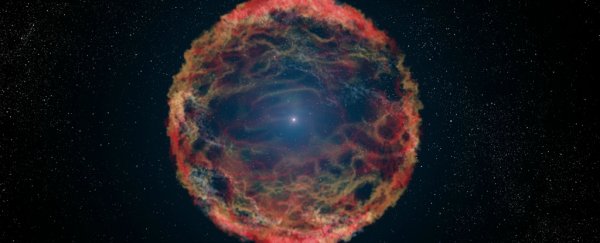If you think about it, astronomers haven't been studying the skies for very long. The first telescope was invented in 1608, based on an early patent by Dutch eyeglass maker Hans Lippershey, and while that seems like a long time ago, it's nothing compared to the age of humanity or - on a much larger scale - the Universe.
But just because our ancestors lacked the ability to fully study objects in space, doesn't mean they ignored the events taking place in the sky. In fact, when researchers today want to study events that happened long ago, they often turn to ancient astronomers who worked with little to no tools, which is exactly what's happening right now with SN 1006 - a supernova that exploded over 1,000 years ago.
Since there are no actual scientific documents to help today's astronomers study the supernova, which shined about as bright as Venus for three months in 1006 AD, researchers from Germany have turned to an unlikely source: Islamic philosopher Ibn-Sīnā, who wrote a number of influential works during the Islamic Golden Age.
One of Ibn-Sīnā's most notable works is the Kitab al-shifa (The Book of Healing), written around 1013 AD. According to the team led by R. Neuhauser from Jena Observatory, a passage in The Book of Healing could provide insights into how people on the ground viewed SN 1006.
As Gizmodo's Andrew Liptak reports, when translated, it reads:
"It therefore happens that the burning and flaming stays for a (long) while, either in form of a lock of hair or with a tail [i.e. in form of a comet], mostly in the north, but sometimes also in the south, or in form of a star among the stars [kawkab min al-kawakib] - like the one which appeared in the year 397.
It remained for close to three months [qarıban min thalathat ashhur] getting fainter and fainter until it disappeared; at the beginning it was towards a darkness and greenness, then it began to throw out sparks [yarmı bi-l-sharar] all the time, and then it became more and more whitish and then became fainter and disappeared. It can also have the form of a beard or of an animal with horns or of other figures."
While this description is nothing compared to the complex reports astronomers make today, it's the next best thing. As of right now, the team is unsure if the description was made first-hand, or was told to Ibn-Sīnā by someone else.
Either way, it's a remarkable find in an ancient work that is now of use to modern scientists who were not around to study the event.
Besides offering a glimpse into what people said during SN 1006's three-month illumination, the passage offers scholars a way to gauge where the philosopher was when he witnessed it, which is something scholars have been wondering for a while now.
The team's findings have been published on the pre-print website, arXiv.org, and are awaiting peer-review.
